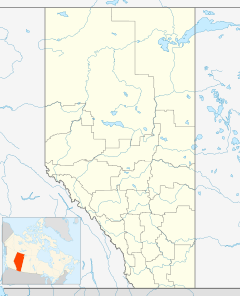Milo, Alberta facts for kids
Quick facts for kids
Milo
|
|
|---|---|
|
Village
|
|
| Village of Milo | |

Milo seen from the east
|
|
| Motto(s):
Making Memories in Milo
|
|
| Country | Canada |
| Province | Alberta |
| Region | Southern Alberta |
| Census division | 5 |
| Municipal district | Vulcan County |
| Founded | 1909 |
| Incorporated | |
| • Village | May 7, 1931 |
| Area
(2021)
|
|
| • Land | 0.96 km2 (0.37 sq mi) |
| Elevation | 880 m (2,890 ft) |
| Population
(2021)
|
|
| • Total | 111 |
| Time zone | UTC−7 (MST) |
| • Summer (DST) | UTC−6 (MDT) |
| Postal code span |
T0L 1L0
|
| Area code(s) | 403 |
| Highways | Highway 542 Highway 842 |
| Waterway | McGregor Lake |
Milo is a small village in Vulcan County, Alberta, Canada. It is located on Highway 542. Milo is about 127 kilometers (79 miles) southeast of the city of Calgary. It is also 72 kilometers (45 miles) east of the town of High River. Milo is mainly a community that supports local farming.
Contents
People Living in Milo
In 2021, a count of the population was done by Statistics Canada. The Village of Milo had 111 people living there. These people lived in 51 homes out of 58 total homes. This was a small increase from 91 people in 2016.
The village covers a land area of 0.96 square kilometers (0.37 square miles). This means there were about 116 people living per square kilometer in 2021.
Fun Things to Do and Places to Go

Milo has many places for people to gather and have fun. There is a community hall for events and a curling rink. You can also find walking paths and a skating area. The village has a library and a school.
For food and shopping, Milo has a grocery store, a pub, and a cafe. The local Lions Club helps keep a nice playground and picnic area. If you need more services, the town of Vulcan is about 50 kilometers (31 miles) away.
Near Milo, you'll find McGregor Lake. This lake has a campground with 85 spots. McGregor Lake is a big part of an irrigation system. It is also a popular spot for many water activities. People enjoy fishing, swimming, windsurfing, and boating here. It's also a great place for birdwatching.
Milo's Story
Early Days
Milo was first settled in 1909. It was about 3 kilometers (1.9 miles) northeast of where it is today. Jens (Jim) and Alete Aasgard moved there and opened a store and their home. The town was named after Milo Munro, who was the first postmaster. His post office was inside the Aasgards' store. Soon, a blacksmith shop and a bank also opened nearby. Before 1920, Milo had a telephone office, a butcher, a pool hall, a community hall, and an ice cream parlor.
Moving the Village
A new railroad line was built in the area, but it did not reach the original Milo. So, in 1924, the entire village was moved. Most of the buildings were pulled to the new spot next to the train tracks. The town hall was too big to pull in one piece. It was taken apart and rebuilt at the new location. Milo officially became a village in 1931.
A War Hero from Milo
A brave Royal Canadian Air Force navigator named Harlo "Terry" Taerum grew up near Milo. He was the son of a Norwegian immigrant and went to school in the community. In May 1943, he was part of a famous mission called "Operation Chastise." This mission is also known as the "Dambuster Raid." Terry Taerum guided the lead bomber at a very low height, at night, to its target in Germany. He was sadly killed on another mission in September 1943.
Modern Milo
In 1985, a new community hall was built in Milo. The curling rink was made bigger and improved in 1998. Since the year 2000, new homes have been built along the shores of McGregor Lake. These homes attract people who want to live by the lake or vacation there, especially from Calgary. The original site of the village, where the Aasgards' farm and store were, is now part of Canada's largest comb honey beekeeping farm. This farm is owned by Don and Ron Miksha.


